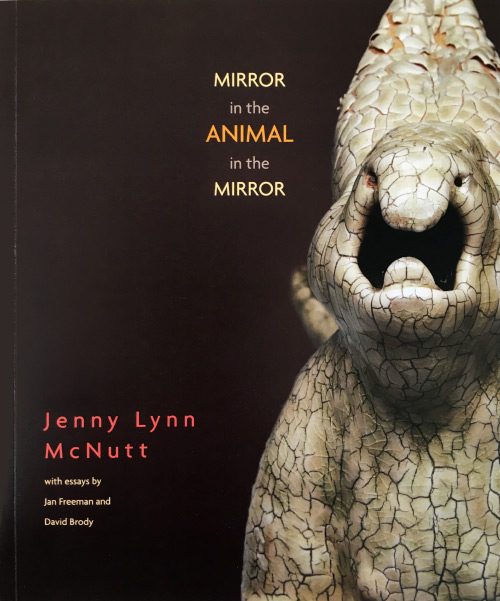Excerpts from Catalogue essays from Mirror in the Animal in the Mirror, 2017
Mirror in the Animal in the Mirror
Excerpt
“The eye sees only fronts, and the mind, on the whole, is satisfied with fronts. But intuition needs all-roundness and instinct needs insideness. The true imagination is forever curving round to the other side, to the back of presented appearance.” —D.H. Lawrence on Cézanne
Like contemporary crossover clay masters such as Mary Carlson, Ann Agee, and the late Ken Price, McNutt plays with ceramic perfectionism, not only in her modeling but, as in Chimera, with her use of exotic glazes. The figurine effect McNutt achieves is leverage against the gravity of the existential and environmental crisis she is addressing. The deftness opens the floodgates of pathos. And then again, McNutt sometimes revels in pugnacity. The exuberant curling forms and aggressive textures of Bathsheba, studiously derived from a turtle carapace with an eye to prehistory, arrives at something like the funk vibe of Niki de Saint Phalle and Robert Arneson. The piece, not incidentally, was made during a residency in the hometown of Hieronymus Bosch, and the addition of a lewd, studded tongue is ultimately a Surrealist gesture in Bosch's spirit, by way of Max Ersnt and Méret Oppenheim, et al. Finally, McNutt also uses sculpture to explore pure gestural abstraction –– or almost pure as with Bird Mountain, in which the creatures of the title are barely sketched protuberances on an afflicted, crackling blob of clay. But I remind the reader about note 10 above, as well as the passage by Lawrence: be alert, in this and other works, for hidden caverns containing ribs and sinew, parables and metaphors, and restless instinct.
— David Brody, artist and writer 2017
david-brody.com
. . .
This Dangerous Continuum: Jenny Lynn McNutt’s Mirror in the Animal in the Mirror
Excerpt
We encounter shape changers in McNutt’s new work. The artist pushes our comfort and extends the meticulous forms of animals, reptiles, birds, and human limbs of her earlier work. The ecstasy and pain of her Pope Joan series dissolve into a primal ground with encasements of shell, bone, earth, with organs exposed. The frog appears in tangled piles; the sea turtle on her back is still, a long life stopped; the hare hangs upside down or kneels before us exposed, limbs splayed.
Mirror in the Animal in the Mirror presents continuum and doom, a warning. In McNutt’s exploration of the human stamp on the natural world, the dire consequences of climate change and human destruction cover our visual field. And still she explores regeneration, the future. In her artist statement, she offers us Edward O. Wilson’s term biophilia: “our intrinsic urge to affiliate with other creatures. Our 21st century responsibility in the management of biological life.”
— Jan Freeman, writer and Founder & Director of Paris Press 2017
janfreeman.net
Catalogue: Mirror in the animal in the mirror

With essays by Jan Freeman and
David Brody
Catalogue Design by Charles Yuen
Printed by: Rolling Press, Brooklyn, NY
Available for: $20